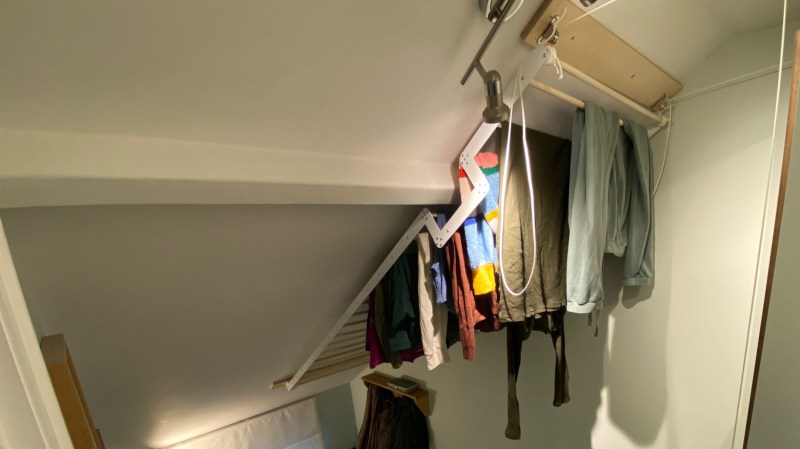Finding space to dry clothes can be challenging in smaller spaces. [Tom Parker] solved this conundrum in his one bedroom apartment by putting a drying rack in his stairwell.
By making the laundry rack fold up above the stairwell, [Parker] can dry his clothes without them taking up a lot of precious floor space. A pole is used to is raise and lower a dowel rod attached to two lines of paracord running over pulleys and to the end of the rack. Each moving corner of the rack also has a set length of cord attached to prevent the rack from rotating too far down as well as providing a safety mechanism should one of the other lines of cord snap.
The rack is bolted-together, laser cut 1.5mm thick mild steel with 15 mm dowels attached to the sides via threaded inserts. Spacing is set for the raised rack to put clothes at 75 mm apart. Plywood pieces interface the rack with the wall to avoid damaging the drywall.
If you’re looking for more laundry hacks, check out this Smart Clothes Dryer or How Robots Suck at Folding Laundry.
















putting the clothes to dry in a corner like this, so close to the drywall will favor mold on the drywall. Only bathroom drywalls (the green type) have the specific water barrier. The cardboard layer will delaminate, and mold will grow on the surface. Workarund: Add a fan for moving air around.
You’re right. But in this case he lives in a one bedroom apartment. That means he might only be doing one or two loads a week, so he might not have any problems. There also appears to be a window nearby, so opening that could also increase airflow enough.
Or one load a fortnight, if he owns 15 pairs of socks like I do.
I have enough space to dry on a rack in the upstairs workshop (or spare bedroom as the estate agents called it), but really have seen no sign of any damp or condensation caused by drying (spin-dryed) clothes.
Drying clothes indoors is the single most common reason for mould, damp and mildew in homes. Use a proper dryer that vents to the outside in the winter and if you have a yard or other outside space, dry your clothes outside the rest of the year.
A load of washing gives off about as much moisture over 24 hours as one person living in the house by perspiration and breathing. If that much is a problem, it’s the ventilation that is the issue and not the wet clothes.
Space for an externally venting tumble dryer is not always a given, particularly as it requires space on an exterior-facing wall (which for a terraced house is only the front and back walls). Also requires permanent modification to drill the vent hole, so not viable in many cases.
Drying outside is fine for many – weather permitting – but not fun at all for hayfever sufferers.
I still have the mock wanted poster “Your clothes dryer is wasting energy”. A quarter of a your home furnace is blowing outside while that much air has to come from the outside and it’s cold. During mild winter times like right now that dryer can heat the house. One of these caloric loads is FREE, or pay double.
Yes a small fan should blow at a rack of drying clothes anywhere indoors, it gets done faster. A lot of places don’t have enough fresh air. In tight construction it’s worse, such is the recent fuss over gas stoves. Ventilate. No added smell or softeners please, weather indoors or out. It stinks when I smell “laundry” going down the street on my bike and see nothing.
OMG I cannot believe the comments about mold, Have any of you actually done laundry and dried them the old fashioned way and hang them outside or even inside if you prefer, I have been living in a two bedroom apt for 15 years and dry them in my bedroom because I heard that 120 volt dryers are useless (no mold yet)
Just how much water do you think clothes that come out of a washing machine contain, I would be willing to bet it would be in the neighbor hood of a couple grams
“a proper dryer that vents to the outside in the winter”
AKA an inefficient dinosaur. Modern high efficiency dryers are basically dehumidifiers.
Yeah, but are they going to last 30 years like ours has?
All the comments about mould, mildew, etc. – as valid as those thoughts are, without knowing for sure what the HVAC system is in this apartment is and the ambient humidity levels, it could work quite well. Some buildings are quite dry and you have to use humidifiers to keep the air tolerable. Also, if he were to run a fan to keep the air circulating, then he would be okay. Remember toilets with the lids left up are spewing moisture into the air as well as your body, water in the sink, when you take a shower/bath, and when you cook. I applaud this effort – great idea!
Not sure where you live, but no one (or at least only a rich minority) in my city has HVAC in their homes (Johannesburg has the best weather in the world 😀), and no one gets mould when drying their clothes indoors (not being close to the ocean).
When I lived at the coast, I did get mould sometimes, but surely for the the majority of this planet’s residents, this won’t be a problem?
I use a dryer.
Me too